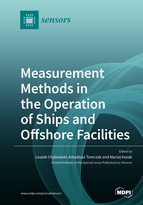Measurement Methods in the Operation of Ships and Offshore Facilities
A special issue of Sensors (ISSN 1424-8220). This special issue belongs to the section "Fault Diagnosis & Sensors".
Deadline for manuscript submissions: closed (31 December 2020) | Viewed by 46747
Special Issue Editors
Interests: diesel engines; operation and maintenance; reliability and safety; energy conversion; failure prevention; directed innovations; marine systems; machinery; propulsion systems; TRIZ; inventics; modelling; fault prediction; condition monitoring
Special Issues, Collections and Topics in MDPI journals
Faculty of Navigation, Maritime University of Szczecin, Szczecin, Poland
Interests: navigation; hydrography; positioning systems; INS; data analysis; estimation
Special Issues, Collections and Topics in MDPI journals
Faculty of Mechatronics and Electrical Engineering, Maritime University of Szczecin, Szczecin, Poland
Interests: power electronics; ship electrical systems; real-time programming; control of electrical converters.
Special Issues, Collections and Topics in MDPI journals
Special Issue Information
The development of modern measurement methods for ship systems results from economic changes and increasingly stringent environmental requirements. At the same time, the specificity of ship systems and the conditions in which they work produce very restrictive requirements for the reliability and accuracy of measuring systems on ships and offshore facilities. The digitization of many processes carried out on ships, oil rigs, platforms, etc. intensifies their complexity and increases security requirements. This Special Issue is dedicated to research in the field of measurement methods and condition monitoring of marine systems. We encourage authors to publish the results of their research related to the development of modern systems on ships and offshore facilities, in particular concentrating on measurement and assessment of processes occurring in ship propulsion systems, ship navigation systems, maritime communications, maritime safety and alarm systems, marine cargo handling equipment, offshore technological systems, etc.
This Special Issue will address all types of sensors and measurement systems designed for ships and offshore facilities. This Special Issue provides an advanced forum for the science and technology of sensors and measuring systems. Regarding marine systems such as ships and offshore facilities, the scope of the SI will be tackling mostly topics associated with physical sensors, remote sensors, smart/Intelligent sensors, sensor devices, sensor technology and application, signal processing, data fusion, sensor interfaces, human–computer interaction, sensing systems, and localization and object tracking.
Prof. Dr. Leszek ChybowskiProf. Dr. Arkadiusz Tomczak
Prof. Dr. Maciej Kozak
Guest Editor
Manuscript Submission Information
Manuscripts should be submitted online at www.mdpi.com by registering and logging in to this website. Once you are registered, click here to go to the submission form. Manuscripts can be submitted until the deadline. All submissions that pass pre-check are peer-reviewed. Accepted papers will be published continuously in the journal (as soon as accepted) and will be listed together on the special issue website. Research articles, review articles as well as short communications are invited. For planned papers, a title and short abstract (about 100 words) can be sent to the Editorial Office for announcement on this website.
Submitted manuscripts should not have been published previously, nor be under consideration for publication elsewhere (except conference proceedings papers). All manuscripts are thoroughly refereed through a single-blind peer-review process. A guide for authors and other relevant information for submission of manuscripts is available on the Instructions for Authors page. Sensors is an international peer-reviewed open access semimonthly journal published by MDPI.
Please visit the Instructions for Authors page before submitting a manuscript. The Article Processing Charge (APC) for publication in this open access journal is 2600 CHF (Swiss Francs). Submitted papers should be well formatted and use good English. Authors may use MDPI's English editing service prior to publication or during author revisions.
Keywords
- Marine systems
- Ships propulsion
- Marine power plants
- Navigation equipment
- Communication equipment
- Ship handling
- Ships and offshore facilities
- Condition monitoring
- Safety and security systems
- Alarm systems









